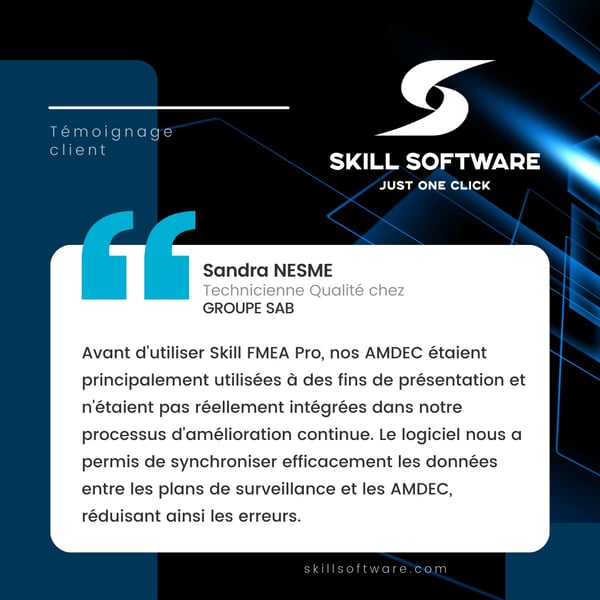[Success story SAB Group] Adopting a dedicated FMEA tool: guaranteeing audit compliance and speeding up quality project management
Published: July 8, 2025
In an increasingly complex and competitive industrial environment, risk management and process quality have become key issues for companies. FMEA (Failure Modes, Effects and Criticality Analysis) is a fundamental tool for identifying and assessing potential risks in systems and processes. However, effective implementation of this methodology requires the right tools and a proactive approach.
In this interview, Sandra Nesme, Quality Technician at SAB Group, shares her experience of the importance of a dynamic, integrated approach to FMEA, and the benefits of a specialized software solution, Skill FMEA pro. In particular, she discusses the challenges of compliance during audits, time savings in project management, and the importance of a close relationship with the software publisher.
Find out how this feedback can shed light on best practices and innovations that can transform risk management within organizations.
Could you tell us about yourself and the challenges you face when it comes to FMEA?
"I'm in the quality department and I'm in charge of managing and writing FMEAs, monitoring plans and manufacturing flowcharts.
Following internal observations and feedback from auditors, we decided to modernize our FMEA approach and switch to a dedicated tool, which was to replace Excel. We had to navigate between several files, and as a result, FMEAs and monitoring plans were not synchronized, leading to inconsistencies and errors. So we had to equip ourselves with a dedicated solution."
Using Excel to manage FMEAs presents several technical limitations compared to a dedicated software solution. Excel, being a general-purpose spreadsheet, has no predefined structure for FMEA. This forces users to manually create and maintain complex formats, increasing the risk of errors and inconsistencies. Indeed, Excel does not integrate features specific to the FMEA method, such as automatic calculation of criticality indices, generation of standardized reports or management of corrective actions.
Unlike specialized software, Excel does not allow you to centralize FMEA data in a single database. The multiplication of files can make it difficult to update and synchronize information between different documents (FMEA, monitoring plans, etc.). In addition, this tool does not offer advanced version management and modification traceability functions, which are essential for tracking the evolution of FMEAs over time. Finally, using Excel can make it difficult to work collaboratively in real time, involving file exchanges which increase the risk of version conflicts.
Can you tell us about the benefits and results of using Skill Software's solution?
"Using Skill FMEA Pro software has been very beneficial. During the IATF audit, we received strong points for our FMEAs, which impressed the auditors. The software allows us to note the number of hours spent on FMEAs, which demonstrated our investment and rigor. In terms of results, we've seen considerable time saved on projects. The software centralizes the management of FMEAs, monitoring plans and manufacturing flowcharts, guaranteeing document consistency and reducing the risk of errors."
The use of a tool specialized in FMEA management offers a multitude of technical and operational advantages, particularly in terms of compliance during audits and efficiency in the management of FMEA projects.
These tools facilitate adherence to industry standards, such as IATF 16949, which governs the automotive sector. By integrating the specific requirements of these standards, dedicated software ensures that the FMEAs produced meet auditors' expectations. Thanks to traceability and modification history functionalities, it becomes easy to demonstrate the evolution of analyses and corrective actions implemented over time. What's more, these solutions offer advanced reporting capabilities, enabling the rapid generation of detailed, customized reports, essential during audits. The ability to quantify the time invested in each FMEA is a major asset in illustrating a company's commitment and rigor in its risk management approach.
In terms of efficiency, specialized FMEA software offers a number of time-saving features. Data centralization, for example, enables FMEAs, monitoring plans and manufacturing diagrams to be grouped together on a single platform. This approach eliminates the need to juggle multiple files, reducing the risk of errors and the time spent searching for information. In addition, the automation of complex calculations, such as risk priority indices, simplifies analysis and minimizes potential errors.
These software solutions also offer predefined models and libraries of failure modes, speeding up the creation of new FMEAs while ensuring consistency of approach. Real-time updating of associated documents, such as monitoring plans, ensures that changes made to a FMEA are automatically reflected, eliminating the need for manual updates.
In addition, real-time collaboration features enable teams to work simultaneously on the same documents, considerably reducing the time needed to exchange information. Finally, integrated tracking tools facilitate the management of corrective and preventive actions, enabling faster implementation and more effective monitoring of improvements.
Which elements of the Skill FMEA Pro solution and Skill Software support do you find most beneficial?
"The Skill Software team is very supportive, responsive and attentive to our needs. When we have questions, we know we can call them and get a quick answer. Even in terms of evolution, they are open to suggestions for improvements and actively participate in their implementation."
The responsiveness and availability of an FMEA solution provider are essential to ensure operational continuity. When a company encounters technical difficulties or questions, a rapid response helps to minimize interruptions and maintain productivity. Effective support ensures that users can resolve problems quickly, which is particularly important in time-critical environments where errors can have costly consequences.
What's more, the software publisher's customer focus and attentiveness make it easy to adapt the software to users' specific needs. Companies often have specific requirements depending on their business sector, internal processes and quality objectives. A responsive editor can gather valuable feedback and propose software enhancements or customizations that precisely meet these needs. This not only optimizes software use, but also increases customer satisfaction and loyalty.
In addition, the software publisher's ability to incorporate user suggestions for improvement into software updates is a key success factor. This demonstrates a commitment to co-development and partnership, where publisher and customer work together to continuously improve the product. This collaborative approach can lead to significant innovations and improvements in software functionality, making the tool more powerful and better adapted to current and future challenges.
In a few words, how would you describe Skill Software and their Skill FMEA Pro solution?
"The software is easier to use than it looks, saves time, and customer support you can count on."



